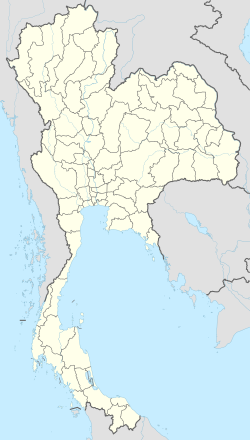Chiang Klang Airport (ICAO: VTCD) is a former military airport located in Chiang Klang district, Thailand.
| Chiang Klang Airport | |||||||
|---|---|---|---|---|---|---|---|
สนามบินเชียงกลาง | |||||||
| Chiang Klang district, Nan province in Thailand | |||||||
| Coordinates | 19°18′00″N 100°51′00″E / 19.30000°N 100.85000°E | ||||||
| Type | Military airstrip | ||||||
| Site information | |||||||
| Operator | United States Air Force Royal Thai Air Force | ||||||
| Condition | Decommissioned, now managed by Wat Phra That Cho Hae | ||||||
| Site history | |||||||
| Built | 1957 | ||||||
| Built by | United States with Thai support | ||||||
| In use | 1957 - August 1, 1976 | ||||||
| Battles/wars | Vietnam War | ||||||
| Events | CIA operations in the Cold War | ||||||
| Airfield information | |||||||
| Identifiers | ICAO: VTCD | ||||||
| |||||||
History
editIn 1957, Chiang Klang Airport was established to support transportation for operations of the Central Intelligence Agency (CIA) during the Cold War. Afterwards, it served as a small airstrip for military and transport. In 1962, the airport was expanded to accommodate larger aircraft with a longer gravel runway. The runway was reinforced with Marston Matting for operations of the United States Air Force and Royal Thai Air Force.[1]
Vietnam War
editDuring the Vietnam War, the airport supported flights and operations from Nakhon Phanom and Udorn. It was mainly used to aid in military operations along the border. During the Vietnam War, the base supported flights and operations from bases in Nakhon Phanom and Udorn. It was mainly used to aid in military operations along the border. In early 1968, two O-1 aircraft and four additional Forward Air Controllers (FACs) were deployed to Chiang Klang Airport as part of the visual reconnaissance program and to control air strikes. Later, in an effort to provide coverage in northern Thailand, DASC 3, which support the Royal Thai 3rd Army, was moved from Chiang Klang to Lampomg and Nan. Soon afterwards, it was collocated with the 3rd Army Tactical Operations Center at Phitsunalok. Additionally, Chiang Klang Airport had operational low frequency beacons.[2] From 1969 to 1970, Chiang Klang Airport was used by Air America’s de Havilland Canada DHC-4 Caribous to shuttle rice across the border to an airstrip designated as LS-60A, Xieng Lom.[3][1] On 13 January 1970, an RTAF Douglas C-47 Skytrain took off at the airport and crashed. There were 6 occupants and 1 fatality was recorded, and the aircraft was written off.[4]
Closure
editIn March 1976, the Thai Government ordered to withdraw all US military installations and stations. [1][5] After the withdrawal of US troops, Chiang Klang Airport ceased operations and was later given to Wat Phra That Cho Hae, a royal temple, to be managed by the local authorities. The ownership transfer was finalized on August 1, 1976. [1]
References
edit- ^ a b c d Border Patrol Police Division 325. Chiang Klang Airport was established in 1957 to support transportation for “CIA” operations. It served as a small airstrip for military and transport planes. Later, in 1962, the airport expanded to accommodate larger planes with a longer gravel runway. The runway was reinforced for use by both the Royal Thai Air Force and the U.S. Air Force. The airstrip area covers approximately 208,000 square meters. During the Vietnam War, the base supported flights and operations from bases in Nakhon Phanom and Udorn. It was mainly used to aid in military operations along the border. This airstrip ceased operations after the conflict and was later given to Wat Phra That Cho Hae, a royal temple, to be managed by the local authorities. The ownership transfer was finalized on August 1, 1976., Memorial
- ^ "Project CHECO Report" (PDF). Defense Technical Information Center. Retrieved 3 November 2024.
- ^ "Airport Information: Chiang Klang". Thai Flying Club. Retrieved October 31, 2024.
- ^ "ASN Aircraft accident Boeing 737-2A1 9M-MHT". Aviation Safety Network. Retrieved October 31, 2024.
- ^ "THAILAND ORDERS LAST U.S. FORCES TO LEAVE BY JULY". The New York Times. Retrieved November 6, 2024.

